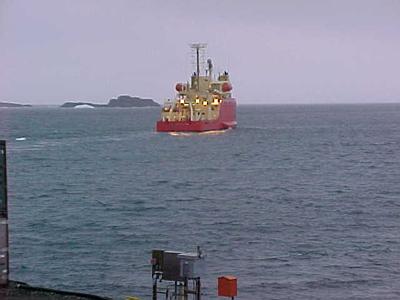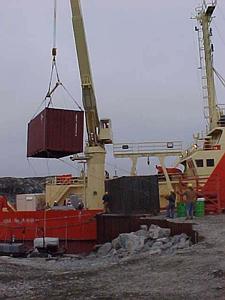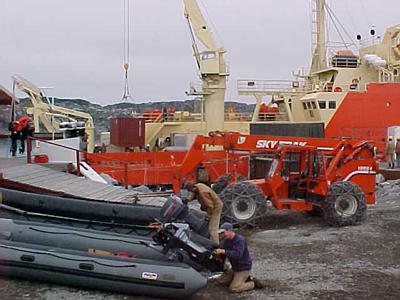20 March, 2000
Gould leaves; End of summer
Question 30: Besides leopard and crabeater seals, what other seals are found
in the Southern Ocean?
Yesterday morning the R.V. Laurence M. Gould arrived back at Palmer after
completing its oceanographic cruise. As soon as it arrived, the dock area was
full of activity. First the science gear on its decks had to be stowed for
travel back to Chile. Then all the cargo from the station (mostly packed in
vans) had to be loaded onto the ship and secured. This retrograde cargo
consists of personal items from crew that were here all summer, station trash,
lab waste, and scientific gear for projects that are not currently underway.
The station does not have huge areas for storage, so large items that will not
be needed for a season or more are returned to the warehouse in Punta Arenas.
Some of the science cargo is for completed projects, and those items will make
their way back to the States from Chile.
Not only is this the last day of summer on the calendar (remember--southern
hemisphere), it is definitely the last day of summer for the station. The
winter ASA (Antarctic Support Associates) group that arrived with us has had
almost two weeks of changeover time, working with the summer people they are
replacing. The first large group of these summer crew members (11) leaves on
the Gould tonight. The station will be down to 34 people.
The station and the ship usually eat separately so as not to put a strain on
the food budgets of either. Last night, however, we had pizza for 85 in the
lounge in GWR and had the passengers and crew ashore! Appropriately called
cross-town pizza. Today everyone is rushed. Departing crew members are
finishing up last minute parts of their jobs (some, such as the Boating
Coordinator, will not have winter replacements), getting their gear on board,
and saying goodbye to friends and the station.
Ross and Sparky are breaking down the fleet of Zodiacs. For the winter there
will be only three on the water--our dive boat, the Search and Rescue boat,
and one general use work boat. Most of the others have been taken out of the
water already. Bruiser and Low Rider are the only two left to remove. Each
boat is attached by straps to the forklift end of a SkyTrak, lifted out of the
water and deposited by the boat house. The SkyTrak is then used to transfer
the heavy gear platforms out of the boats and up onto the storage deck. After
the boat motors are cleaned, the SkyTrak puts them up onto the railing of the
boat house. The LTER science groups will spend the next several days breaking
down the equipment inside the boat platforms and packing it up for the season.
When the Gould left, everyone on station gathered out on the dock to say
goodbye. The gangplank was stowed. The lines were released from shore and
pulled onto the ship. We waved at all the passengers gathered on the upper
deck as the ship pulled away with huge blasts of its horn.
Answer 29: Krill are tiny animals, similar in appearance to tiny shrimp,
which are an important part of the food chain in the Southern Ocean. The most
abundant species is Euphausia superba, which can reach 60 millimeters long
(about 2 1/2 inches). They swarm in large groups.

R.V. Laurence M. Gould departing Hero Inlet.

Bruiser hanging from the Sky Trak.

The Gould's crane loading a storage van from the Palmer Station dock.

Ross and Sparky cleaning boat motors with the Gould being loaded behind them.

Sparky unmooring and attaching cables to Bruiser.

Contact the TEA in the field at
.
If you cannot connect through your browser, copy the
TEA's e-mail address in the "To:" line of
your favorite e-mail package.
|
